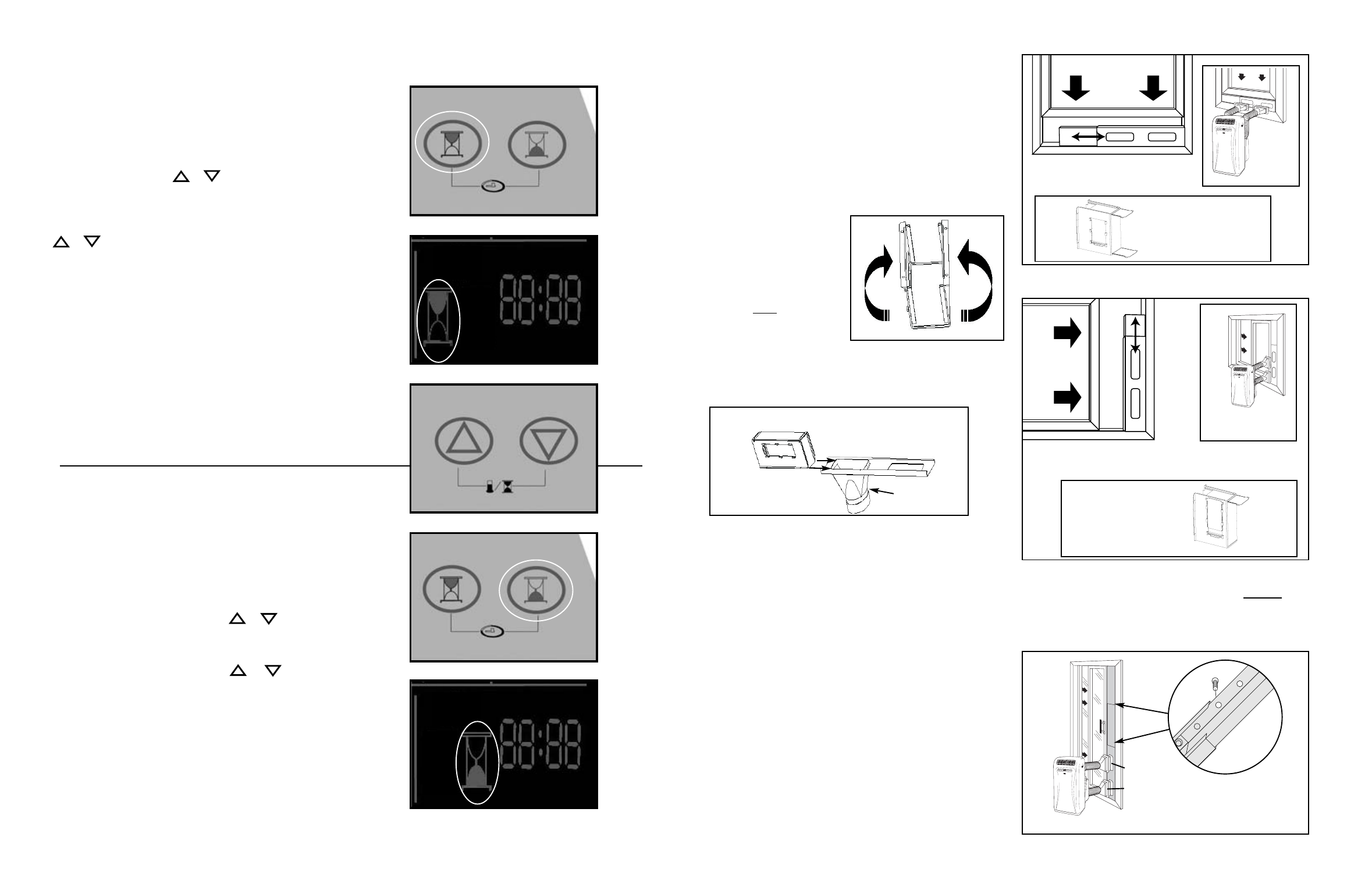
Réglage de la MINUTERIE EN MARCHE AUTO (suite) :
4.Tous les réglages sont maintenant enregistrés.
5.Pour régler la minuterie EN MARCHE AUTO, l’unité
doit être hors de service.
6. Appuyer sur la touche EN MARCHE AUTO (Fig K)
pour initialiser la séquence de temporisation.
MINUTERIE EN MARCHE apparaîtra sur l’affichage
(Fig L) et les chiffres des minutes clignoteront.
Appuyer sur les touches ou RÉGLAGE
TEMP/HEURE pour choisir les minutes EN MARCHE
AUTO. Appuyer sur la touche MINUTERIE EN
MARCHE de nouveau et les chiffres des heures
clignoteront (Fig M). Appuyer sur les touches
ou RÉGLAGE TEMP/HEURE pour choisir
l’heure de mise en service EN MARCHE AUTO.
Appuyer sur la touche MINUTERIE EN MARCHE de
nouveau et l’affichage indiquera HORLOGE / EN
MARCHE et l’heure réglée EN MARCHE AUTO.
Appuyer sur les boutons de l’horloge (MINUTERIE EN
MARCHE / MINUTERIE À L’ARRÊT) simultanément
pour revenir au réglage de l’heure du jour de l’horloge.
L’unité sera automatiquement mise en service à l’heure
réglée EN MARCHE AUTO. Pour annuler ou
contourner le programme EN MARCHE AUTO,
activer l’unité en tout temps avant l’heure préréglée
pour le fonctionnement. Vous pouvez vérifier l’heure
EN MARCHE AUTO réglée en tout temps (avant
l’activation par le programme) en appuyant sur la touche
MINUTERIE EN MARCHE. L’heure réglée apparaîtra
sur l’affichage.
Réglage de la MINUTERIE ARRÊT AUTO :
Avant de régler la minuterie ARRÊT AUTO, l’horloge
(heure du jour) doit être réglée et/ou opérationnelle.
1. Pour régler la minuterie ARRÊT AUTO, l’unité doit être
activée (par le commutateur I/O).
2. Appuyer sur la touche MINUTERIE À L’ARRÊT
(Fig N) pour initialiser la séquence de temporisation
ARRÊT AUTO. MINUTERIE À L’ARRÊT apparaîtra sur
l’affichage (Fig O) et les chiffres des minutes
clignoteront. Appuyer sur les touches ou
RÉGLAGE TEMP/HEURE pour choisir les minutes
ARRÊT AUTO. Appuyer sur la touche MINUTERIE À
L’ARRÊT de nouveau et les chiffres des heures
clignoteront. Appuyer sur les touche ou
RÉGLAGE TEMP/HEURE (Fig M) pour choisir
l’heure de mise hors de service ARRÊTAUTO. Appuyer
sur la touche MINUTERIE À L‘ARRÊT de nouveau et
l’affichage indiquera HORLOGE / À L‘ARRÊT et l’heure
réglée ARRÊTAUTO. Appuyer sur les boutons de
l’horloge (MINUTERIE EN MARCHE / MINUTERIE À
L’ARRÊT) simultanément pour revenir au réglage de
l’heure du jour de l’horloge. L’unité sera
automatiquement mise hors de service à l’heure réglée
ARRÊT AUTO. Pour annuler ou contourner le
programme ARRÊT AUTO, mettre l’unité hors de service
en tout temps avant l’heure préréglée pour la mise hors
de service.
36F
Fig K
Fig L
Fig N
Fig O
Fig M
Window / Patio Door Kit Installation
(Air Conditioning Mode ONLY)
Your window kit has been designed to fit most
standard “vertical” / “horizontal” windows and patio
doors up to a maximum height of 80”. For vertical
window and/or patio door applications, multi-lock
positions are provided on the edge of each slider
section. Two lock screws are provided to secure
each section together. Fig. 5a.
Rain Hood Assembly
1) Fold both sides of
the Rain Hood 90
°
as so
the flanges are facing
outward. Fig 1
2) Slide the Rain Hood
flanges onto
the edges of
the slider kit until it is
lined up with the intake
vent (shown in Fig 2). Once the mounting holes on
the slider, as well as the Rain Hood are aligned,
secure theRain Hood to the slider with the four
mounting screws provided.
IMPORTANT:
• For horizontal window kit applications refer to
figure 3a for correct Rain Hood insert positioning.
• For vertical window kit applications (including patio)
refer to figure 4a for correct Rain Hood insert
positioning.
1) Select a suitable location,making sure you have
access to an electrical outlet.
2) Install both flexible hoses to the rear side of the
unit. Both hoses are identical and can be installed
into either opening. Insert the hose collar with the 2
lock tabs into the 2 slots on the top of each opening
and twist to lock into position.
3) Install the adjustable Window/Patio Door Slider
Kit as required. Fig’s. 3, 4, 5.
4) Install the window exhaust adapters into the
openings in the slider section, making sure the
window slider sections are secure.
Important:: Ensure the exhaust adapter labeled “air
intake” is installed on the hose that is connected to
the air intake opening on the back of the unit.
Horizontal Window
Window Slider Kit
Minimum: 28" (71.1 cm)
Maximum: 48
3
/8" (123 cm)
Vertical
Window
Fig. 3
Fig.4
Patio
Door
Patio Door Kit
Minimum: 28" (67.5 cm)
Maximum: 80" (203 cm)
Fig. 5
Fig. 5a
Please Note: In a vertical application, the
exhaust hose MUST be positioned above
the
intake hose in the window slider. See Fig 5.
This will avoid having the exhaust heat go
through the intake and back into the unit.
7
Window Slider Kit
Minimum: 28" (71.1 cm)
Maximum: 48
3
/8" (123 cm)
Fig. 3a
A
B
Fig. 2
Fig. 1
Rain hood inserts are
installed in “A” and “B”
postions with vent
opening facing down (C)
C
Fig.4a
A
B
C
Intake hose
adapter
Rain
Hood
Slider kit
Rain hood inserts are
installed in “A” and “C”
positions with vent
opening facing down (B)
Rain Hood is to be installed only over air intake vent
Air exhaust
Air intake
Plug the unit into a 115 V / 60 Hz grounded
electrical outlet.


















